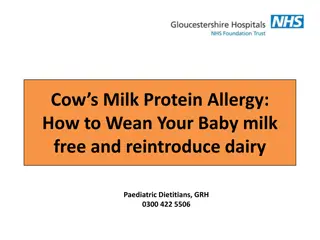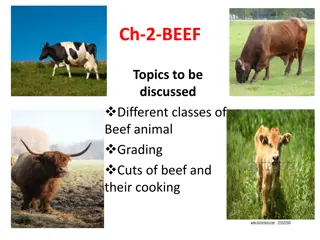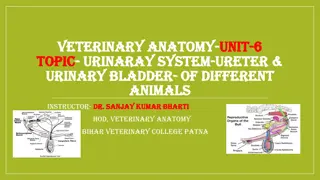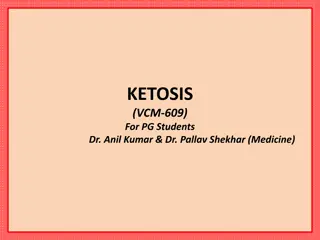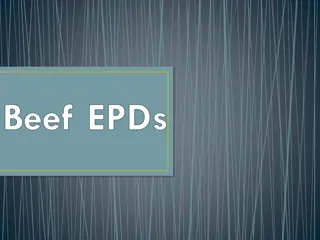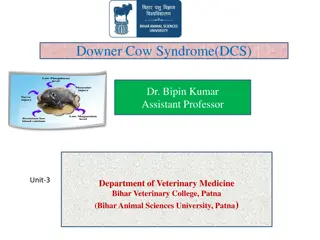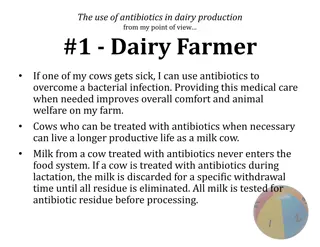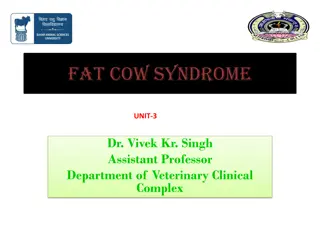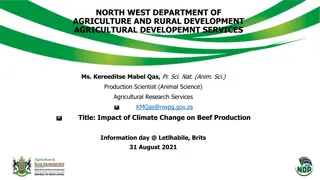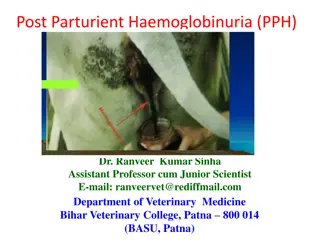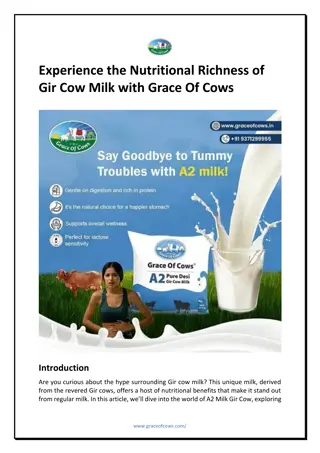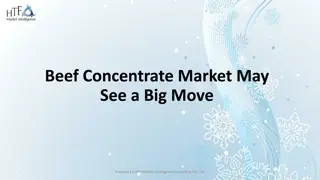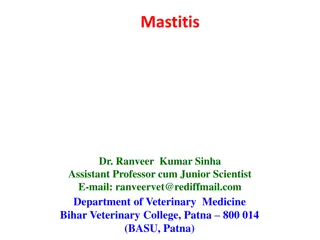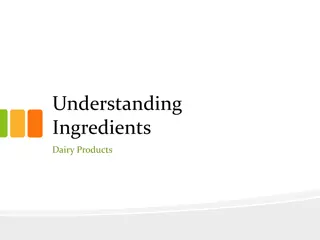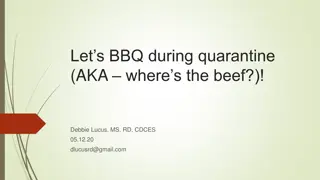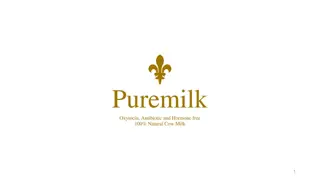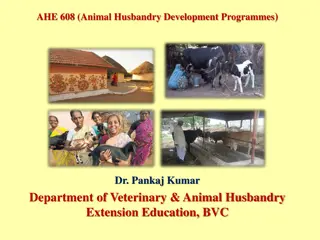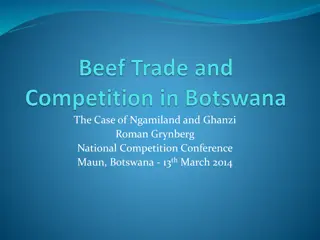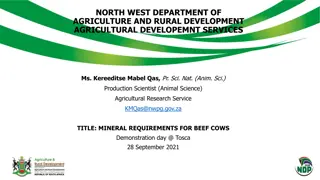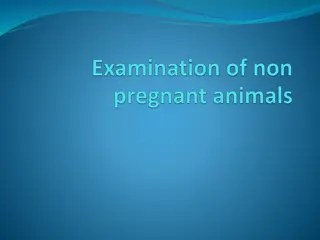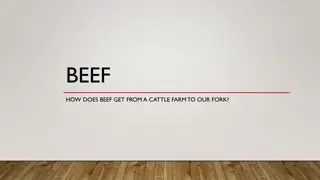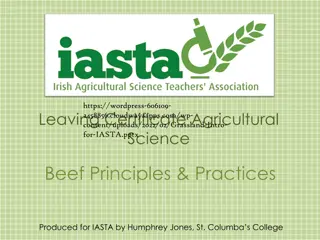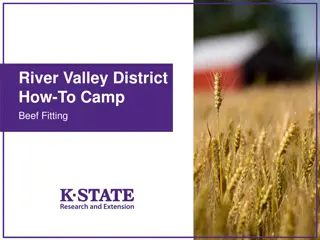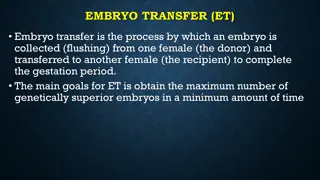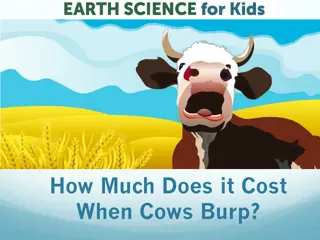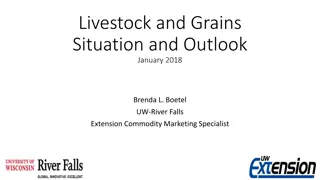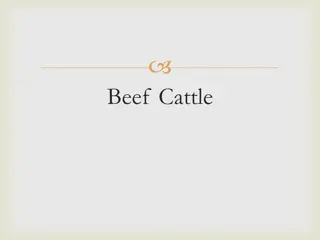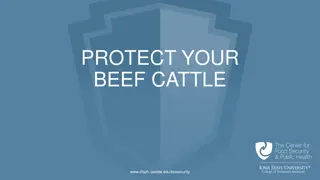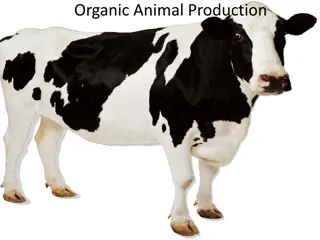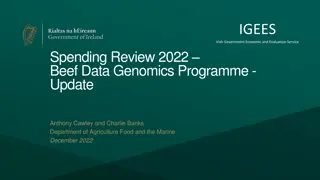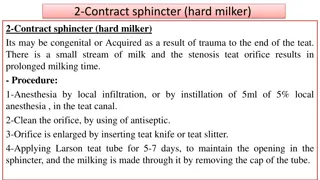Managing Cows Milk Protein Allergy (CMPA) in Infants: Weaning and Reintroduction Guidelines
Cows Milk Protein Allergy (CMPA) in infants can present various symptoms and challenges. This guide covers the diagnosis, symptoms, weaning strategies, reintroduction of dairy, alternative products, and meeting nutritional needs. Learn to differentiate between CMPA and lactose intolerance for proper
1 views • 31 slides
Understanding Downer Cow Syndrome (DCS) in Cattle
Downer Cow Syndrome (DCS) is characterized by the inability of cows to rise, commonly seen around calving. It is associated with metabolic disorders, physical injuries, and prolonged recumbency. Risk factors include poor housing conditions and health issues like mastitis. Clinical signs range from d
2 views • 13 slides
Insights into Milk Composition and Processing
Worldwide, milk is collected from various animals such as cows, goats, sheep, yaks, and water buffalo. The composition of milk includes water, lactose, butterfat, protein, and minerals, each playing a vital role in its nutritional value. The butterfat content determines the richness of dairy product
7 views • 41 slides
Understanding Different Classes of Beef Animals and Their Grading
Different classes of beef animals, including cow, bull, calf, ox, heifer, and more, are discussed along with their characteristics and purposes. The process of grading beef, which provides information on taste and palatability, is also explained. Additionally, cuts of beef and their cooking methods
0 views • 20 slides
Veterinary Anatomy of Urinary System in Different Animals
The urinary system in animals includes kidneys, ureters, and the bladder, all crucial for filtration and urine excretion. The ureters are excretory ducts from the kidneys, while the bladder stores urine before expulsion. Various diagrammatic structures illustrate the urogenital system of animals, pa
0 views • 20 slides
Understanding Bovine Ketosis in Dairy Cows
Bovine ketosis is a metabolic disease affecting lactating dairy cows, characterized by weight loss, reduced milk production, and neurological abnormalities. It is primarily caused by a negative energy balance post-parturition, leading to the mobilization of body fat and protein stores for energy pro
0 views • 11 slides
Understanding Expected Progeny Differences (EPDs) in Beef Cattle Selection
Expected Progeny Differences (EPDs) in beef cattle breeding predict future offspring performance based on genetic merit. They help compare animals as parents and aid in selecting for traits like birth weight, weaning weight, and yearling weight. Combining EPDs with visual appraisal improves decision
0 views • 15 slides
Understanding Downer Cow Syndrome in Dairy Cattle
Downer Cow Syndrome (DCS) is a condition affecting dairy cows, characterized by prolonged recumbency despite treatment with calcium. It often occurs after milk fever and can lead to various complications. This article covers the etiology, clinical symptoms, prevention, and management strategies for
2 views • 10 slides
Perspectives on Antibiotics Use in Dairy Production
Dairy farmers use antibiotics to treat sick cows for improved animal welfare; organic dairy farmers face restrictions but benefit from higher premiums; concerns about antibiotic resistance in children debunked by medical professionals; milk processors prioritize food safety through rigorous testing
0 views • 6 slides
Understanding Fat Cow Syndrome in Cattle: Causes, Symptoms, and Treatment
Fat Cow Syndrome, also known as Fatty Liver Disease in Cattle, is a condition commonly seen in high-producing cows during the transition period around calving. The disease is characterized by mobilization of excessive body fat to the liver due to negative energy balance, leading to hepatic lipidosis
1 views • 10 slides
Livestock Breeding Policy for Genetic Improvement of Cattle and Buffalo in India
India's diverse agro-ecological regions host a wide range of farm animal breeds. The livestock breeding policy aims to enhance the productivity of cattle and buffalo through strategies such as grading up with indigenous superior dairy breeds, crossbreeding with high-yielding exotic breeds, and selec
1 views • 23 slides
Impact of Climate Change on Beef Production: Insights from Research
Climate change significantly impacts beef production through various factors such as heat stress, nutritional stress, and altered disease patterns. Livestock are uniquely affected by climate change and also contribute to it through methane emissions. Adapting to changing weather conditions is crucia
0 views • 12 slides
Post-Parturient Haemoglobinuria (PPH) in Dairy Cows and Buffaloes: Causes and Clinical Manifestations
Post-Parturient Haemoglobinuria (PPH) is a metabolic disease affecting high-producing dairy cows and buffaloes. It is characterized by intravascular hemolysis, hemoglobinuria, and anemia. The condition is mainly caused by phosphorus deficiency, ingestion of certain plants, and increased phosphorus r
0 views • 19 slides
Grace Of Cows
\nGrace Of Cows offers premium A2 Milk from these revered bovines, renowned for their superior milk quality. Discover the unparalleled richness, creaminess, and health properties that set A2 Milk from Gir cows apart, and enjoy the ultimate dairy expe
6 views • 5 slides
Beef Concentrate Market ppt
Global Beef Concentrate Market Breakdown by Application (Food and Beverage Industry, Nutritional Supplements, Pet Food, Foodservice Sector) by Type (Liquid Beef Concentrate, Powdered Beef Concentrate, Paste Beef Concentrate) by Distribution Channel (
0 views • 8 slides
Mastitis in Cows: Causes, Treatment, and Prevention Strategies
Mastitis is a common and costly disease affecting dairy cows, caused primarily by bacterial infections. Symptoms in cows include decreased milk production, changes in milk quality, and potential death if left untreated. Dr. Ranveer Kumar Sinha shares insights on the etiology, treatment options such
0 views • 15 slides
Understanding Post-Parturient Haemoglobinuria in Dairy Cows
Post-Parturient Haemoglobinuria (PPH) is a metabolic disease affecting high-producing dairy cows after calving, characterized by hemolysis, hemoglobinuria, and anemia. Common in buffaloes and cows, it is caused by phosphorus deficiency in diet, affecting intracellular functions and leading to clinic
0 views • 9 slides
Exploring Dairy Products and Milk Varieties
The article delves into the realm of dairy products, focusing on various types such as milk, cheese, yogurt, cream, and butter. It explains how milk, produced by mammals like cows and sheep, serves as a vital source of nutrition for infants. Additionally, it details different heat treatments applied
3 views • 75 slides
Let's BBQ During Quarantine: Where's the Beef?
Debbie Lucus, MS, RD, CDCES, shares tips for BBQing during quarantine. The article includes a fun BBQ image and provides contact details for Debbie. It also humorously asks, "Where's the Beef?" The content discusses BBQing ideas and recipes for a delicious at-home BBQ experience.
0 views • 19 slides
Reducing Emissions in the Beef Sector: Draft Report from Food Vision Beef Group Meeting
Draft report from the Food Vision Beef Group's fourth meeting on September 1, 2022, at Backweston focuses on planning to reduce emissions associated with the beef sector. The report contains 17 measures derived from discussions held over the past two months.
1 views • 25 slides
The Dark Reality of Milk Industry Adulteration in Kolkata
A shocking exposé reveals the grave dangers lurking in Kolkata's milk industry - cows injected with illegal drugs, contaminated feed and water, and mafia operations. Milk available in the market is tainted with fatal adulterants like oxytocin, antibiotics, and growth hormones, posing serious health
0 views • 26 slides
Understanding Dugongs: Marine Chordates of the Ocean
Dugongs, known as sea cows, are fascinating marine chordates with a broad but fragmented range in tropical waters. They exhibit social behaviors, communicate through echoing sounds, and are herbivorous grazers feeding on seagrasses. Breeding season rituals involve courtship behaviors like vocalizati
0 views • 7 slides
Animal Husbandry Development Initiatives in India: Gaushalas and Gosadans
Animal Husbandry Development Programmes in India have a rich history dating back thousands of years, with initiatives like Gaushalas and Gosadans playing a significant role in preserving indigenous cattle breeds, promoting milk production, and supporting rural economies. Gaushalas aim to breed and u
0 views • 10 slides
Sustainable Trade Solutions for Ngamiland's Beef Industry
The presentation discusses the challenges facing Ngamiland's beef industry due to Foot-and-Mouth Disease (FMD) and explores the potential of adopting a Commodity Based Trade (CBT) approach to revive the economy. By transitioning to CBT, Ngamiland could potentially expand its market access while addr
0 views • 9 slides
Mineral Requirements for Beef Cows Demonstration Day at Tosca
Essential minerals play a crucial role in the growth and reproductive performance of beef cows. Divided into macro and micro categories, these minerals are necessary for skeletal development, milk production, and overall body function. While some minerals are readily available in forage, supplementa
0 views • 20 slides
Fuzzing Cows: The No Bull Talk on Fuzzing Security
This presentation at B-Sides Ottawa in 2010 discussed the concept of fuzzing in security, its history, objectives, and limitations. It aimed to raise awareness about fuzzing as an option in assessments and product evaluations, sharing challenges, real examples, and motivating the audience to start f
0 views • 46 slides
Best Practices for Rectal Palpation in Veterinary Medicine
Rectal palpation is a crucial diagnostic method in veterinary medicine for assessing the reproductive health of animals like cows, buffaloes, mares, and camels. This technique helps in determining the normal and abnormal conditions of genital organs, aiding in pregnancy diagnosis and differentiating
0 views • 18 slides
Journey of Beef from Farm to Fork
Beef production involves a process starting from cattle farms where cows give birth to calves, followed by the growth stages including nursing, weaning, auction, grazing, feeding in feedyards, and eventually harvesting in processing facilities. The final beef cuts are distributed to supermarkets and
0 views • 11 slides
Overview of Beef Farming in Ireland
The beef industry in Ireland plays a vital role in the country's agricultural economy, with millions of beef animals producing a significant amount of beef annually. However, despite its importance, beef farming has the lowest income per hectare compared to other farming types in Ireland. This overv
0 views • 72 slides
Beef Showmanship and Fitting Tips for Successful Campers
Explore essential tips for successful beef showmanship and fitting at camp in the River Valley District. Learn how to perfect your routine, enhance your skills, and excel on show day with expert guidance and insights. Whether you're a beginner or seasoned camper, these tips will help you elevate you
0 views • 4 slides
Tennessee 4-H Meat Judging Presentation: Beef Hindquarter Retail Cuts Identification
In this presentation featuring beef hindquarter retail cuts, students learn to identify different primal and retail cuts of beef such as Loin, Round, Sirloin, and Flank. Each cut is displayed with accompanying features to aid in recognition and understanding. The presentation helps students develop
0 views • 32 slides
Embryo Transfer in Cattle: Benefits, Process, and Considerations
Embryo transfer (ET) in cattle allows for the production of genetically superior offspring, increasing milk production and weaning weights. While offering advantages like rapid genetic improvement and flexibility in genetics transfer, ET also presents challenges such as increased costs and disease r
0 views • 20 slides
The Cost of Cattle Emissions and Climate Change Impact
Cows are major sources of methane emissions, leading to carbon footprint issues and climate change. Scientists are studying ways to reduce these emissions, as governments consider fees on cattle farmers for cows' burps. The cost implications, from AC bills to failed crops, highlight the urgent need
0 views • 17 slides
Livestock and Grains Situation and Outlook Analysis for January 2018
Brenda L. Boetel, a Commodity Marketing Specialist, evaluates the Livestock and Grains situation for January 2018. The analysis covers key aspects such as Commercial Meat & Poultry Production, Meat Disappearance in the US, Pork Production, Beef Export Trends, and Future Predictions for the Cattle In
0 views • 25 slides
Overview of Beef Cattle Breeds and Characteristics
In the United States, there are over 80 recognized breeds of beef cattle, each with its own advantages and disadvantages. British breeds like Angus and Hereford offer low birth weight and high fertility, while European breeds like Charolais and Simmental excel in growth rate and milk production. Oth
0 views • 24 slides
Protect Your Beef Cattle: Prevent Diseases and Ensure Animal Health
Diseases can harm the health of beef cattle and lead to costly consequences. Learn how to protect your herd by taking biosecurity measures to prevent the spread of diseases. This material, developed with support from USDA, emphasizes the importance of proactive steps to safeguard your beef cattle.
0 views • 5 slides
Organic Animal Production in the US: Insights and Statistics
Organic animal production in the US involves raising livestock and poultry through natural practices without antibiotics or hormones. Animals are fed organic feed and have access to outdoor spaces to mimic natural behavior. Statistically, over 5 million acres of land are certified for organic animal
0 views • 19 slides
Kentucky Cattlemen's Association Long-Range Plan Overview
Kentucky Cattlemen's Association has outlined a comprehensive long-range plan for 2020-2025, focusing on cultivating value-added marketing opportunities, strengthening research and outreach, enhancing engagement and advocacy, and developing organizational infrastructure. The plan includes strategies
1 views • 11 slides
Update on Irish Government's Beef Data Genomics Programme
The spending review for 2022 provides key findings and recommendations on the Beef Data Genomics Programme in Ireland. The analysis shows positive trends in genetic gain, with recommendations for a new iteration focusing on data-driven schemes and holistic approaches to improve sector sustainability
0 views • 4 slides
Teat Canal Disorders in Dairy Cows: Causes and Procedures
Teat canal disorders such as contract sphincter, enlarged teat orifice, calculus, polyps, and teat orifice occlusion can affect milk flow in dairy cows. Procedures for addressing these issues include local anesthesia, orifice cleaning, enlargement, and removal of obstructions. Images provided depict
0 views • 5 slides
